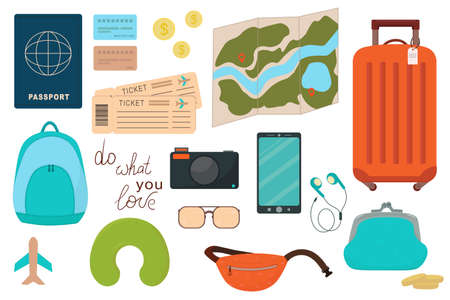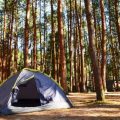1. Choosing the Right Solo-Friendly Campsite
Solo camping in forest and lake areas can be an incredibly rewarding experience, offering solitude, connection with nature, and personal growth. But choosing the right campsite is key to staying safe and making your trip enjoyable. Here are some essential tips to help you select a solo-friendly spot that’s perfect for your adventure.
Proximity to Trails and Ranger Stations
When youre camping alone, its smart to stay within a reasonable distance of maintained hiking trails and ranger stations. Trails mean foot traffic, which adds a layer of safety in case you need help. Being near a ranger station ensures quicker access to assistance during emergencies.
Recommended Distance Guidelines
| Location Feature | Recommended Distance |
|---|---|
| Hiking Trails | Within 0.5 to 1 mile |
| Ranger Station or Checkpoint | Within 2 to 5 miles |
Check Cell Signal Availability
Before setting up camp, check your phone’s signal strength. While you might want to disconnect from digital life, having at least minimal cell service can be a lifesaver in an emergency. Apps like AllTrails or Gaia GPS can show you coverage maps for various carriers in wilderness areas.
Look for Well-Maintained Sites with Low Wildlife Activity
Avoid remote or overgrown spots that may attract wildlife or lack visibility. Look for designated campsites known for cleanliness and safety. These often have fire rings, flat ground, and good drainage—all important for a comfortable solo stay.
Features of a Solo-Friendly Campsite
| Feature | Why It Matters |
|---|---|
| Flat Terrain | Makes pitching your tent easier and more stable. |
| Good Drainage | Keeps you dry during rainstorms. |
| Visible Trail Markers | Helps prevent getting lost when exploring nearby. |
| Low Animal Activity Signs | Reduces risk of unwanted wildlife encounters. |
| Nearby Water Source (100-200 ft away) | Convenient but not too close to avoid bugs or flooding. |
Avoid Isolated or Unregulated Areas Your First Time Out
If youre new to solo camping, stick to well-known parks or campgrounds with established rules and services. National Forests, State Parks, and Army Corps lakeside recreation areas are great places to start. They offer the beauty of nature without being too far off the grid.
Use Online Reviews and Forums for Extra Insight
Campsite review platforms like The Dyrt, Campendium, or Reddit’s r/camping community can provide valuable real-life feedback from fellow campers. Look for mentions of safety, noise level, accessibility, and overall solo-friendliness before deciding where to pitch your tent.
Helpful Resources for Finding Campsites:
- Recreation.gov – Federal campsite reservations and info
- The Dyrt – User-submitted campsite reviews and maps
- FreeCampsites.net – Great for budget-friendly options
- Campendium – Especially useful for RV and car campers but also has tent sites listed
Selecting the right solo campsite sets the tone for your entire adventure—prioritize safety, accessibility, and comfort so you can focus on enjoying the peaceful beauty of forests and lakes all around you.
2. Essential Safety Gear and Preparation
When heading out for a solo camping trip in the forest or by a lake, staying safe should be your top priority. Being alone means you’re fully responsible for your well-being, so packing the right safety gear and knowing how to handle unexpected situations is key.
Must-Have Safety Gear for Solo Campers
Here’s a quick breakdown of essential safety items every solo camper should bring:
| Item | Purpose | Why It Matters |
|---|---|---|
| First Aid Kit | Treat cuts, scrapes, burns, insect bites | You won’t have anyone else around to help with minor injuries |
| Emergency Beacon (PLB or Satellite Messenger) | Sends SOS signal with your GPS location | Essential if you’re in remote areas with no cell service |
| GPS Device or Offline Maps App | Navigation and route tracking | Helps prevent getting lost when trails are unmarked or hard to follow |
| Headlamp or Flashlight with Extra Batteries | Lighting during nighttime or emergencies | A must-have if you’re setting up camp after sunset or exploring after dark |
| Multi-tool or Knife | Cutting rope, food prep, emergency fixes | A versatile tool that can solve many small problems quickly |
Preparing for Wildlife Encounters
Forests and lakes are home to all kinds of wildlife—from curious raccoons to larger animals like bears or moose. Here’s how to stay safe:
- Store Food Properly: Use bear-proof containers or hang your food in a tree at least 10 feet off the ground and 4 feet from the trunk.
- No Food in Your Tent: Even snacks left behind can attract animals overnight.
- Carry Bear Spray (If in Bear Country): Know how to use it before your trip—it can deter aggressive wildlife if needed.
- Make Noise While Hiking: Talk, sing, or carry a bear bell to avoid surprising animals.
Coping with Sudden Weather Changes
The weather in the wilderness can shift quickly—especially near lakes and in forested mountain regions. Be prepared by following these tips:
- Check Weather Forecasts: Always check local conditions before heading out and monitor changes on a weather app if you have service.
- Pack Layers: Bring moisture-wicking base layers, insulating mid-layers, and waterproof outer layers—even in summer.
- Shelter Readiness: Ensure your tent is waterproof and has a reliable rainfly. Practice setting it up before you go.
- Avoid Low Ground During Storms: Set up camp on higher ground to reduce flooding risks during heavy rain.
Quick Tip:
If youre unsure about what to pack, make a checklist based on your destinations terrain and climate. When youre solo camping, being over-prepared is better than underprepared.
Your Safety is Your Responsibility
No matter where youre headed—deep into the woods or along a tranquil lakeshore—the right gear and preparation can make all the difference. Planning ahead helps ensure that your solo adventure stays fun, peaceful, and above all, safe.

3. Solo Camping Best Practices
Heading out on a solo camping trip to a forest or lake site can be an unforgettable experience, offering peace, self-discovery, and a deep connection with nature. But being alone in the wild also means taking extra steps to ensure your safety and comfort. Here are some key best practices every solo camper should follow.
Set Up Camp Smart
Choosing the right spot and setting up your campsite properly is crucial when youre on your own. Look for flat, dry ground away from hazards like dead trees or flood zones. If youre near a lake, make sure youre not too close to avoid bugs and rising water levels during rainstorms.
Solo Camp Setup Checklist
| Task | Why It Matters |
|---|---|
| Pick a visible and safe location | Easier for rescue if needed; avoids wildlife paths |
| Set up before dark | Gives you time to adjust and settle in safely |
| Store food securely (bear canister or hung) | Keeps animals away from your tent |
| Keep essentials within reach (headlamp, knife, whistle) | Quick access in case of emergency |
Stay Aware of Your Surroundings
One of the biggest keys to solo camping safety is staying alert. Without a buddy to back you up, its important to always be aware of whats going on around you. Listen for unusual sounds, keep an eye on weather changes, and trust your instincts.
Tips for Staying Alert
- Avoid using headphones or anything that blocks outside noise.
- Check your surroundings regularly—look for animal tracks or signs of recent activity.
- Use landmarks to stay oriented, especially in forested areas where trails can look similar.
- If something feels off, don’t ignore it—relocate or head out if needed.
Let Someone Know Your Plans
This might be the most important step before any solo adventure: tell someone exactly where you’re going and when you expect to return. This gives rescuers a starting point if something goes wrong.
What to Share Before You Go
| Information | Details to Include |
|---|---|
| Your campsite location | Name of park/area, GPS coordinates if possible |
| Your expected return date/time | Add some buffer time just in case plans change slightly |
| Your gear list & supplies | This helps others understand how well-prepared you are |
| Your emergency contact info | Include your cell number and backup contacts if available |
Bonus Tip:
If you’re heading into remote areas without cell service, consider carrying a personal locator beacon (PLB) or satellite messenger device. These tools can send an SOS signal with your location to emergency services even when youre off-grid.
Solo camping is all about planning smart and staying aware. With the right mindset and preparation, youll feel confident exploring the wild on your own terms.
4. Inspiring Forest and Lake Destinations in the U.S.
Solo camping can be incredibly rewarding, especially when youre surrounded by peaceful forests and tranquil lakes. If youre planning a solo adventure, here are some scenic and accessible destinations across the United States that offer both beauty and solitude. Each location is beginner-friendly but also rich with natural wonder for experienced campers.
Boundary Waters Canoe Area Wilderness, Minnesota
The Boundary Waters is a dream come true for solo campers who love water-based adventures. With over a million acres of wilderness and more than 1,000 lakes, this area offers unmatched tranquility. You can paddle from lake to lake, set up camp on secluded islands, and fall asleep to the sounds of loons calling across the water.
Highlights:
- Perfect for canoe camping
- Remote campsites accessible only by water
- Stunning northern lights during fall months
Shasta-Trinity National Forest, California
If you prefer towering trees and mountain views, Shasta-Trinity is an excellent choice. Located in Northern California, this forest includes the majestic Mount Shasta and plenty of alpine lakes. There are several designated campsites that are ideal for solo travelers looking for a mix of seclusion and accessibility.
Highlights:
- Mount Shasta views and hiking trails
- Lake camping at Trinity Lake or Castle Lake
- Diverse wildlife and plant life
The Adirondacks, New York
The Adirondack Park covers over six million acres in upstate New York. It’s one of the largest protected areas in the U.S., making it perfect for solo campers seeking variety. From quiet lakeside campsites to forested trails leading to mountain summits, there’s something here for every kind of adventurer.
Highlights:
- Tons of lean-to shelters for solo hikers
- Great paddling routes through Saranac Lakes
- Breathtaking autumn foliage
Comparison Table of Featured Solo Camping Spots
| Location | Main Features | Best For | Accessibility |
|---|---|---|---|
| Boundary Waters, MN | Canoe routes, remote lakes, wildlife | Paddlers & solitude seekers | Paddle-in access only; permit required |
| Shasta-Trinity NF, CA | Mountains, forests, alpine lakes | Hikers & mountain lovers | Easily accessible by car; multiple trailheads |
| Adirondacks, NY | Lakeside sites, hiking trails, shelters | Paddlers & backpackers | Good road access; many trail options |
No matter which destination you choose, these spots provide a safe and inspiring environment to enjoy nature on your own terms. Whether youre paddling across a calm lake or sitting under the stars beside a forest campfire, solo camping at these locations will leave you refreshed and reconnected with the outdoors.
5. Mindfulness and Mental Benefits of Solo Camping
Solo camping at forest and lake sites offers much more than just a peaceful getaway—it’s also an incredible opportunity to reconnect with yourself. Being alone in nature helps foster self-reliance, brings mental clarity, and creates space for mindfulness that’s hard to find in everyday life. Heres how you can make the most of these benefits during your solo adventure.
Self-Reliance: Building Confidence Through Independence
When youre out there on your own, youre the one making all the decisions—from setting up camp to cooking meals and staying safe. This builds a strong sense of independence and self-confidence. You learn to trust your instincts, solve problems, and take responsibility for yourself—all valuable life skills that carry over into daily routines back home.
Mental Clarity and Emotional Reset
The calmness of a quiet lake or the rustling leaves in a forest can do wonders for your mind. Without constant notifications, emails, or social obligations, your brain finally gets a break. Many solo campers report feeling mentally refreshed and emotionally balanced after spending time in nature alone.
A Deeper Connection with Nature
With no distractions, it’s easier to tune into the natural world around you—the calls of birds, the movement of water, or even just the changing light throughout the day. This connection can spark feelings of awe and gratitude, reminding you of your place within something much bigger.
Tips for Enhancing Mindfulness While Camping Solo
| Activity | Description |
|---|---|
| Journaling | Bring a small notebook to jot down thoughts, observations, or reflections each day. Writing about your experiences can help process emotions and deepen your appreciation for your surroundings. |
| Meditation | Take 10–15 minutes each morning or evening to sit quietly and focus on your breath. Let nature sounds guide your meditation for a calming start or end to the day. |
| Unplugging | Turn off your phone or use airplane mode during your trip. Avoid screens unless necessary for safety. Disconnecting digitally helps you be more present and relaxed. |
A Simple Mindful Routine for Your Trip
- Morning: Wake up with the sun, stretch outside your tent, journal while sipping coffee by the lake.
- Noon: Go for a slow-paced hike—notice the colors, textures, and smells around you.
- Dusk: Meditate as the sun sets; listen to night sounds as they begin to emerge.
This kind of routine not only grounds you but also helps you return home feeling calmer, clearer, and more connected—to both nature and yourself.

